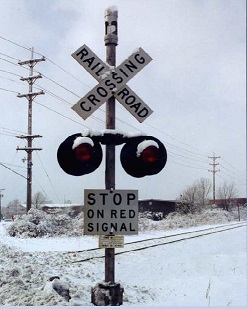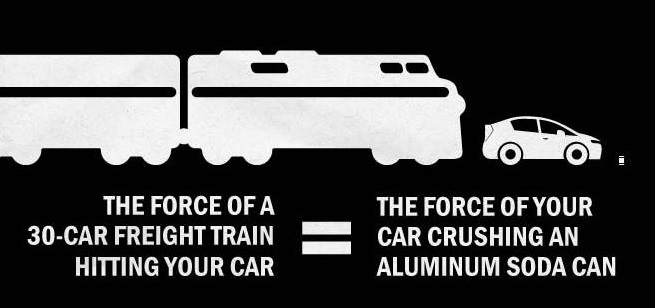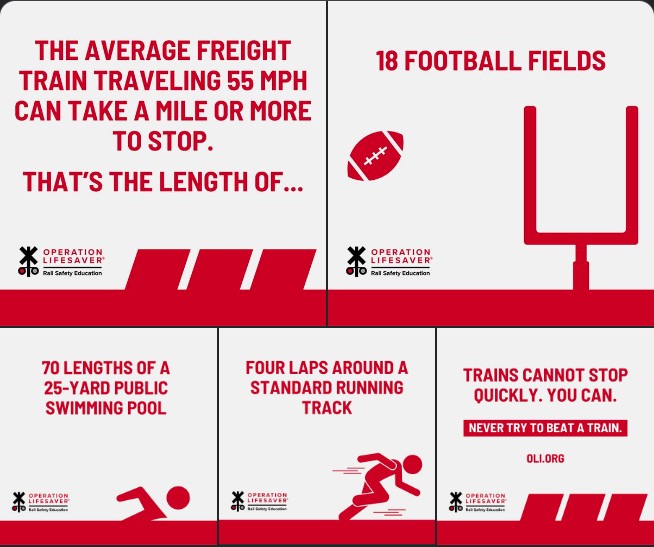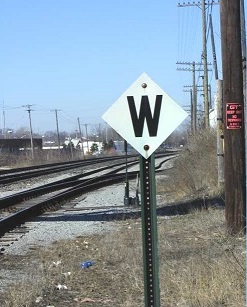



| Contents |
| Overview |
| Public Service Announcement |
| No One Asks The Engineer |
| Enforcement At Crossings |
| Operation Lifesaver Presentations And Videos |
| Arkansas Law Concerning Crossings |
| Railroad Workers Safety |




This poem is from the ''My Testimony --To Soar With Jesus Collection''. Writtten by Daryl Stout. (C) Copyright 1989, 2026 by Daryl Stout. All Rights Reserved. Any abuse or unauthorized usage of this poetry will be dealt with at The Judgment Before Jesus Christ. The ''Soar With Jesus'' Eagle Design was created and designed by Dale Larison, and it is used by permission.
Operation Lifesaver is a national organization that strives to educate the public on the danger of trying to beat a train to a highway railroad crossing. I produced a public service announcement, and wrote a poem a few years ago, on this subject.
The pictures of the grade crossing signal, and the Whistle Post are courtesy of Abacus Software, who at one time, made add-ons for the Microsoft Train Simulator program...but I don't think either are in existence anymore.
The information on this page is WHY they will NEVER seat me on a jury, for a case involving railroad crossing safety...because The laws of physics win every time. It takes far more inertia to STOP a moving object, than to START it moving from a dead stop.
To put it in perspective, one diesel locomotive can weigh in excess of 300 tons, or 600,000 pounds. A fully loaded freight train can be over 12,000 tons, or over 24 million pounds. A typical vehicle can weigh from 1 to 3 tons, or from 2000 to 6000 pounds. The ratio, whether you driving over an aluminum beverage can...or your vehicle being T-boned by a locomotive, is a stunning 4000 to 1 ratio!! In short, IT'S NO CONTEST, as the graphic above illustrates. For a train traveling over 50 miles per hour, it can take over a mile to stop...which is the equivalent of 18 football fields!!
When the car is T-boned by the train, the occupants inside will likely be killed instantly from the force of the collision, or from the coupler on the locomotive piercing through, decapitating the individuals. Or worse, the force could puncture the fuel tank on the vehicle, causing it to ignite, engulfing the vehicle in flames, and burning the occupants alive...such as was the case with the van in this Trains Hit Cars video from Pentrex Railroad Videos.
Basically, once the engineer puts the train into Emergency Stop, the only thing he can do is watch you die!! In short, Stop!! Trains Can't!!.
Worth taking a chance to make up some time??
Worth racing to beat a speeding train to a railroad crossing??
Many people think so...but, many people have been wrong.
So much so, that some have paid for it with their lives.
With most trains traveling over 50 miles per hour, and having close to 100 cars, you're looking at close to 3 miles to bring that train to a stop!!
No...it's not worth the risk...especially when your life is in the balance.
So, the next time you see a train approaching a railroad crossing ahead of you...don't race it!!
Because EVEN IF IT'S A TIE...YOU LOSE!!
A poem about railroad crossing safety
Written By Daryl Stout, Former Member, Arkansas Railroad Club, Little Rock, AR
Railroad crossings dot the land where roads and rails meet.
Crossbuck, lights, bells, and gates...the warnings on the street.
But, STOP ON THE RED SIGNAL seems furtherest from some folks minds,
As they try to beat oncoming trains, to save a little time.
One ton cars...twelve million ton trains...it's no contest to compare.
Are these drivers crazy...or do they just not care??
Fast moving trains with many cars can't stop on a dime.
Not showing up like clockwork...they come at any time.
The sad part is the engineer, who sees it with his eyes.
Many times, day in, day out...all these drivers tries.
He throws the brake on, but he knows there's nothing he can do.
To stop inertia weight behind to keep from plowing through.
Whether a car, fuel truck, or school bus there...no matter what the size.
He sees the horror in their faces just before they die.
Unlike changing traffic lanes, the train cannot be steered
Out of the path of danger there...it's his unending fear.
The nightmare of the crash remains after the wreck is gone.
Many trainmen had to quit...they could not go on.
Sometimes, they too, are maimed or killed, unnecessarily.
And others on the train as well, part of the tragedy.
Had I been that engineer...on that train that day...
And if you asked me about the wreck, here is what I'd say.
''There was no way that I could stop, or out of the way swerve...''
''They ran a red light at the crossing...and got what they deserved''.
So, when you are out driving, and a crossing ahead appears...
Remember in a needless wreck...no one asks the engineer.
And, as noted, the train crew has to live with that the rest of their lives, even though there was nothing they could do to prevent that, and it was not their fault. The US Supreme Court has ruled that ''trains have the right of way at grade crossings, and the law also states that crossing train tracks at anyplace except a designated railroad crossing, is trespassing!!
Next, here are four videos from Operation Lifesaver chapters in Nebraska and Illinois:
1) Look, Listen, And Live -- Tracks Are For Trains, Not For Kids.
2) Emergency Vehicle Railroad Crossing -- Emergency Vehicles and Railroad Crossings.
3) Your License Or Your Life -- Drivers Of Trucks, School Buses, and HazMat Vehicles And Railroad Crossings.
4) A Knock On The Door -- A Parents Worst Nightmare; The News That Their Kids Or Family Member Was Killed Trying To Beat A Train.
5) Norfolk Southern Operation Lifesaver Safety Train
6) Be Safe -- Always Expect A Train
7) From Inside The Locomotive -- Facing Rail Tragedies Head On
8) Operation Lifesaver Railroad Safety Program
Today, we are going to cover the law that covers stopping at railroad crossings. Did you know that 94% of the collisions at railroad crossings are caused by risky driving behavior, or poor judgment on the part of the driver?? Have a little patience and double check your surroundings!
Here are a few ways to NOT become a part of that statistic:
1) Never try to beat a train at a crossing or snake around the lowered crossing gates.
2) Assume that there is a train on every track at all times, even tracks that are rarely used.
3) If there is a stop sign at the crossing, stop! If there is a yield sign or electronic signals, slow and make sure that no trains are approaching.
4) Never cross a railroad track unless you are sure there is room on the other side for your vehicle to completely clear the tracks. Many collisions occur when a vehicle's rear end is still hanging out over the tracks.
(1) A clearly visible electric or mechanical signal device gives warning of the immediate approach of a railroad train;
(2) A crossing gate is lowered or a human flagger gives or continues to give a signal of the approach or passage of a railroad train;
(3) A railroad train approaching within approximately one thousand five hundred feet (1,500') of the highway crossing emits a signal audible from such distance and the railroad train, by reason of its speed or nearness to the crossing, is an immediate hazard; and
(4) An approaching railroad train is plainly visible and is in hazardous proximity to the crossing.
(b) No person shall drive any vehicle through, around, or under any crossing gate or barrier at a railroad crossing while the gate or barrier is closed or is being opened or closed.